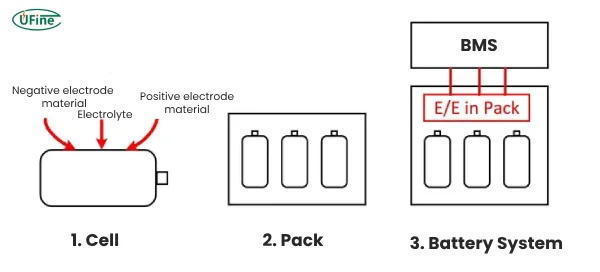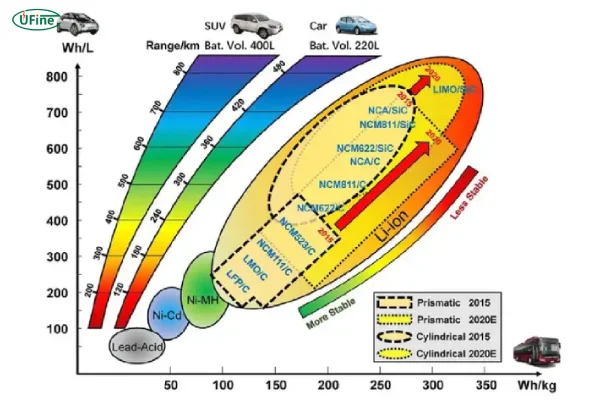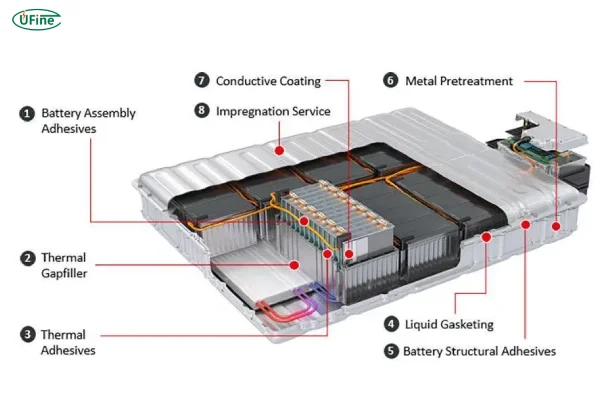
Electric vehicle (EV) batteries are the heart of modern sustainable transportation. However, they are also intricate systems that require a detailed understanding to ensure safety and reliability. To demystify these systems, we can break them down into three core components:
- Cells: The smallest unit comprising the cathode, anode, and electrolyte.
- Battery Pack (Pack): Hundreds or even thousands of cells combined into a unified structure.
- Battery System: Equipped with sensors (to measure voltage, current, and temperature), a Battery Management System (BMS) (to make decisions), and actuators (to execute commands).

Beyond these, a fourth layer—functional safety—addresses the unexpected, safeguarding against risks that arise from unforeseen circumstances or failures. In this comprehensive guide, we’ll explore these four layers in detail.
Part 1. Safety at the cell level
The fundamental danger of lithium-ion batteries lies in thermal runaway, a condition commonly known as catching fire. Unlike traditional fuels like gasoline, which require external oxygen to ignite, lithium-ion batteries can combust within their sealed environment because they contain both oxidizing and reducing agents. This unique property demands rigorous control to ensure safety.
Can More Stable Cells Solve the Problem?
Not all cells are created equal. Some types of batteries are inherently more stable:
- Lithium Iron Phosphate (LFP): These cells are less prone to thermal runaway compared to nickel-based alternatives.
- Nickel-Cobalt-Manganese (NCM): Among nickel-based batteries, NCM is more stable than Nickel-Cobalt-Aluminum (NCA).
- Lower Nickel Content: Within NCM, versions with lower nickel content, like NCM622, offer greater stability than higher-energy-density variants like NCM811.
However, there’s a trade-off: higher energy density typically correlates with lower stability. This relationship underscores the challenge of balancing performance and safety.
Enhancing Cell Stability
Since breakthroughs in battery technology remain on the horizon, current efforts focus on enhancing cell stability through innovative materials and designs. Key strategies include:
- Cathode Materials: Enhancements like doping, coating, or metal atom substitution improve thermal stability.
- Anode Materials: Coating and additives can stabilize the SEI (solid electrolyte interphase) film. New materials like lithium titanate (LTO) or alloy-based anodes also improve safety.
- Electrolytes: Using flame-retardant additives, replacing liquid electrolytes with solid-state alternatives, and introducing overcharge protection additives significantly boost thermal safety.
- Separators: High-safety separators with ceramic coatings can reduce shrinkage and increase the melting point, improving resistance to extreme conditions.
- Protective Mechanisms: Advanced features like Needle Safety Devices (NSD) and Overcharge Safety Devices (OSD) help minimize risks like thermal runaway from punctures or overcharging.
Learn About the Cathode and Anode of the Battery
Improving cell stability is a complex challenge that combines materials science and electrochemistry, particularly as demand for higher energy density grows.
Part 2. Safety at the pack level
While the cell level addresses the intrinsic properties of batteries, the pack level focuses on the battery’s interaction with its environment. This includes factors like heat, pressure, punctures, water exposure, and vibration.
Standards Governing Pack Safety
Battery pack safety is governed by a mix of national and international standards. These ensure that packs are tested under stringent conditions:
- China’s Standards: GB/T 31485-2015, GB/T 31467.3-2015, GB/T 31498-2015.
- International Standards: ISO 12405-2014, IEC 62133-2015, UL 2580-2010, SAE J1929-2011, and JIS-C 8715-2-2012.
The most critical standards include GB/T 31485-2015, IEC 62133, and SAE J2464, which test both cells and packs to ensure comprehensive safety.
Mechanical and Electrical Safety Design
To meet these rigorous standards, packs incorporate multiple layers of protection:
- Mechanical Safety: Fireproof and waterproof designs, flame-retardant materials, and foolproof structures that prevent misuse.
- Electrical Safety: Contact protection, short-circuit prevention, overcurrent protection, high-voltage interlock detection, and insulation monitoring.
China’s standards for battery packs are among the most stringent worldwide, ensuring robust safety measures for new vehicles. However, a lingering concern remains: will these packs remain safe after years of use and potential degradation?
Part 3. Safety at the system level
A battery pack without a control system is akin to a lifeless object. The Battery Management System (BMS) brings the battery to life by serving as its sensory, decision-making, and operational center.
Dual Roles of the BMS
The BMS has two primary responsibilities:
- Core Functionality: Facilitating energy input and output to power the vehicle.
- Monitoring and Safety: Preventing overcharging, overheating, and communication failures.
For instance, China’s GB/T 27930 standard outlines safety protocols for communication between the BMS and charging systems, ensuring protection against faults like overcurrent, overvoltage, and communication disruptions.
Importance of Monitoring
The robustness of these monitoring systems determines how effectively the BMS can detect and mitigate potential failures, such as thermal runaway during charging—a critical moment for battery safety.
Part 4. The fourth Layer: functional safety
Even with robust safety measures at the cell, pack, and system levels, unexpected scenarios can arise. These include severe accidents, prolonged water exposure, or improper maintenance.
What is Functional Safety?
Functional safety addresses the question: What happens when something goes wrong? Unlike other layers, which aim to prevent failures, functional safety focuses on minimizing harm when failures occur.
For example, consider two approaches to a critical problem:
- Use aerospace-grade chips to guarantee no failures but at exorbitant costs.
- Use automotive-grade chips that are cost-effective, combined with fallback mechanisms to ensure safety during malfunctions (e.g., cutting off power and alerting the driver).
The second approach exemplifies functional safety—balancing reliability and cost while safeguarding users in case of failure.
Standards for Functional Safety
International standards like ISO 26262 and China’s GB/T 34590 outline protocols for implementing functional safety in automotive systems. These ensure that even when systems fail, the safety of drivers, passengers, and others on the road is maintained.
Part Addressing challenges in functional safety
Functional safety is still a developing field in China, but steady progress is being made. Challenges include:
- System Architecture: Ensuring robust designs that minimize dependency on external systems.
- Reliability: Balancing cost and reliability to meet safety standards.
- Development Processes: Improving software development protocols, testing methods, and personnel qualifications.
By embracing these challenges, the industry can build EVs that are not only efficient but also resilient in the face of unexpected failures.
Part Conclusion
To ensure comprehensive safety, EV batteries must be evaluated across four dimensions:
- Cell Level: Addressing intrinsic properties through advanced materials and designs.
- Pack Level: Ensuring robustness against external factors through mechanical and electrical safety measures.
- System Level: Providing sensory, decision-making, and operational capabilities via the BMS.
- Functional Safety: Safeguarding against harm during unexpected failures.
An analogy serves as a fitting conclusion:
- Under normal conditions, the cell is the body’s cell, the pack is the skeleton, and the system is the nervous system.
- When things go wrong, functional safety acts as the reflex, ensuring survival and preventing catastrophe.
By addressing these four dimensions, we can create EVs that are not only high-performing but also safe and reliable, paving the way for a sustainable future.
Related Tags:
More Articles

Battery Load Test: A Comprehensive Guide
Step-by-step battery load test guide for car, solar & industrial use. Learn how to load test a battery, interpret voltage charts, and avoid common mistakes.
The Comprehensive Guide to Battery Balancing and Battery Balancer
Discover how battery balancers improve lithium battery performance, lifespan, and safety. Learn types, functions, and tips to choose the right balancer.
What Is the Best Voltage for a Chainsaw Battery?
Compare 12V-80V chainsaw batteries for light pruning, medium firewood, and professional cutting. See best battery chainsaw with runtime charts and safety tips.
Lithium VS. Alkaline Batteries: A Comprehensive Comparison
Lithium batteries last 3–7× longer than alkaline and perform better in cold weather. Compare lifespan, cost, safety, and best uses to choose the right battery.
Comparing Lithium-Sulfur and Lithium-Ion Batteries: Which is Right for You?
Compare lithium-sulfur (Li-S) and lithium-ion batteries on energy, lifespan, cost, safety, and applications. Best choice for drones, EVs, and electronics.




